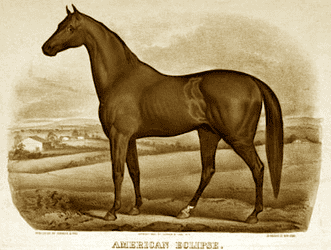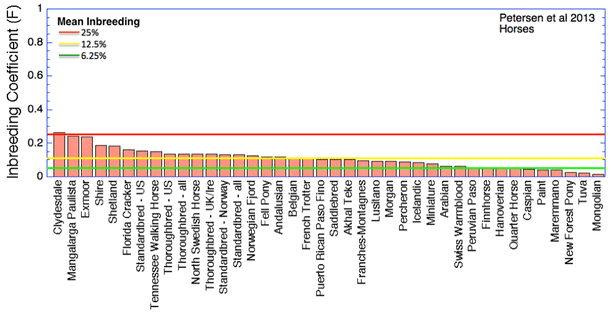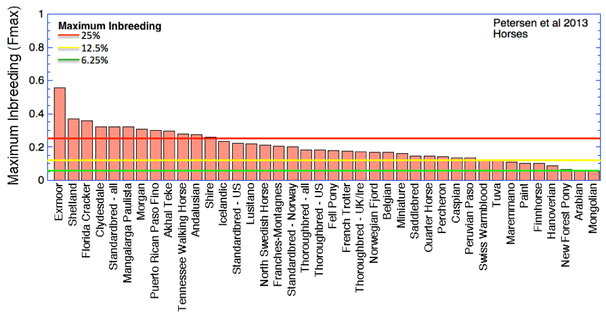| In my previous post (Inbreeding of purebred dogs determined from DNA), I presented a summary of the average levels of inbreeding in dog breeds, taken from a recently published compilation based on direct measurement from DNA (Dreger et al 2016). These data show that most breeds of dogs are highly inbred, with average values that exceed the inbreeding level that results from the mating of half-siblings (12.5%). In fact, more than half of the breeds had average inbreeding coefficients greater than 25%, equal to mating full siblings from unrelated parents. This means that for many breeds, most breedings involve a sire and dam that are more similar genetically than full siblings. |
I plotted these data on the same axes I used for the dog data, and did separate graphs for both the mean level of inbreeding as well as the maximum for each horse breed. (Unfortunately, the maximum values were not reported for the dog data.) As before, I included reference lines for inbreeding levels of 6.25% (green; the result of mating first cousins), 12.5% (yellow; mating of half-siblings), and 25% (red; mating of full siblings).
There are three graphs below. First are the dog data, using the same graph presented in my earlier blog post, but turned horizontally so it's easier to compare to the horse data. (See that blog post for a larger, vertical version of this graph). Below the graph for dogs, there are two graphs for horses: one with the mean inbreeding coefficient for each breed (comparable to the dog data) and a second one with the maximum.
Inbreeding Coefficients in Dogs
(Data from Dreger et al 2016)
(From the blog post Inbreeding of purebred dogs determined from DNA)
Inbreeding Coefficients in Horses
(Data from Petersen et al 2013)
- Mean (top)
- Maximum (bottom)
In horses, even the maximum inbreeding values were greater than 25% in only about a third of the breeds (bottom, red line).
Dreger DL, M Rimbault, BW Davis, A Bhatnagar, HG Parker, & EA Ostrander. 2016. Whole genome sequence, SNP chips and pedigree structure: building demographic profiles in domestic dog breeds to optimize genetic trait mapping. http://dmm.biologists.org/lookup/doi/10.1242/dmm.027037.
Petersen JL, JR MIckelson, EG Cothran, and others. 2013. Genetic diversity in the modern horse illustrated from genome-wide SNP data. PLoS One 8(1): e54997. doi:10.1371/journal.pone.0054997.
ICB's online courses
*******************
Join our Facebook Group
ICB Breeding for the Future
...the science of dog breeding
*******************
Visit our Facebook Page
ICB Institute of Canine Biology
...the latest canine news and research





